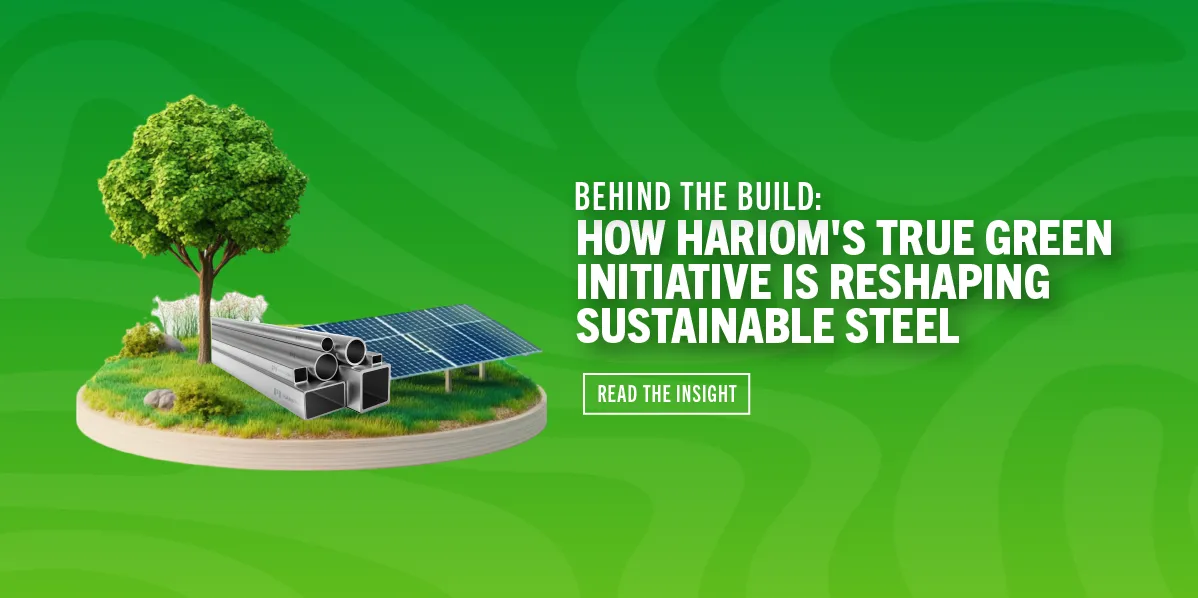Blogs
“Behind the Build: How Our True Green Initiative Reduces Carbon Footprint”
In an era where environmental accountability is shaping procurement, investment, and policy decisions, the role of steel — traditionally seen as an emissions-heavy industry — is undergoing serious transformation. At the forefront of this evolution is Hariom Pipe Industries, where sustainability is not an afterthought, but a foundational business principle.
Through the True Green Initiative, Hariom is redefining how steel is manufactured, consumed, and valued. This initiative is a long-term operational strategy focused on reducing carbon emissions, optimising resource use, and enabling customers to meet their own sustainability goals without compromising strength, quality, or delivery.
This is not a claim. It’s a measurable shift in how steel is built — from the inside out.
Understanding the True Green Initiative
The True Green Initiative is Hariom Pipe Industries’ formal approach to responsible manufacturing. It spans across four primary verticals:
- Renewable energy integration
- Vertical integration of production processes
- Material reuse and recycling
- Product innovation for long-term environmental performance
Each of these areas is mapped to reduce Scope 1 and Scope 2 emissions while also creating downstream impact for infrastructure partners, government contractors, and commercial developers aiming to lower their environmental footprint.
Powered by Renewable Energy
The steel industry is energy-intensive by design. Hariom has actively mitigated this by integrating renewable energy solutions at key stages of its manufacturing cycle. Select facilities are supported by solar infrastructure and energy-efficient rolling mills. These upgrades are not cosmetic — they reduce total electricity consumption per tonne of steel output.
The use of tandem mills allows the company to produce pipes with high precision and lower energy use per section. Additionally, the reduced need for re-processing and thermal correction reduces operational energy draw without affecting the dimensional accuracy of the finished product.
This efficiency means customers sourcing from Hariom are already using steel produced with a smaller carbon footprint than industry benchmarks.
Responsible Water and Waste Practices
Alongside power consumption, water usage and waste disposal are critical elements of environmental impact. Hariom employs closed-loop water cooling systems and internal recirculation units to limit fresh water usage.
Scrap steel is reintegrated into the production process, and slag or ash by-products are redirected for alternate industrial use, such as in the manufacturing of bricks. Even in packaging and dispatch, material optimisation ensures that every shipment is space-efficient and reduces unnecessary logistics emissions.
These practices are not theoretical. They are routine — and audited under the company’s ISO 14001:2015 environmental management certification.
Certification and Compliance
Sustainability without third-party validation carries limited credibility. Hariom’s systems are certified under multiple relevant standards:
-
ISO 14001: Environmental Management Systems
-
ISO 9001: Quality Management
-
ISO 45001: Occupational Health and Safety
-
BIS compliance across key pipe categories (IS 1239, IS 4923, IS 3601, IS 1161)
These certifications ensure that Hariom’s environmental claims are backed by documented operational control, quality monitoring, and statutory compliance across manufacturing, packaging, and delivery.
For government contractors, developers working under LEED or GRIHA frameworks, and buyers responding to sustainability-linked tenders, Hariom’s compliance reduces risk and increases ESG alignment without requiring additional effort from procurement teams.
Sustainable Procurement Starts Here
The relevance of green manufacturing today extends far beyond the factory gate. Architects, civil engineers, and infrastructure planners are now expected to justify material choices not just by strength and cost, but by environmental performance.
Green steel is no longer a niche concept. It is now a serious procurement consideration for:
-
Public infrastructure bids
-
Affordable housing programs
-
Smart city developments
-
Solar and clean energy installations
-
Commercial and industrial construction under ESG investment mandates
Hariom’s True Green-certified production model allows buyers to choose steel that meets both engineering and environmental specifications without compromise.
Looking Ahead
Hariom is not static in its sustainability roadmap. The company is currently evaluating expanded renewable energy deployment across additional plants, including rooftop solar and more efficient load-balancing systems.
R&D initiatives are underway to improve the carbon intensity of billet production.
The long-term goal is not only to maintain internal reductions but to enable downstream customers — including developers and government agencies — to meet carbon reduction targets through responsible material sourcing.
Conclusion
The role of steel in society is unchanging — it remains the backbone of infrastructure. What must change is the way steel is made. At Hariom Pipe Industries, that change is already well underway.
The True Green Initiative demonstrates how a traditional manufacturing sector can evolve with intention, intelligence, and integrity. By reducing emissions, optimising operations, and extending product life cycles, Hariom is making sustainability measurable, accessible, and real.
For those building India’s future, the message is simple: If you're designing for performance and responsibility, Hariom is already building for you.
Partner with Hariom Pipes Today!
To learn more or request True Green-certified products for your next project, visit www.hariompipes.com or speak with our team at 1800 1230 360.


